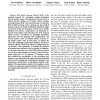Free Online Productivity Tools
i2Speak
i2Symbol
i2OCR
iTex2Img
iWeb2Print
iWeb2Shot
i2Type
iPdf2Split
iPdf2Merge
i2Bopomofo
i2Arabic
i2Style
i2Image
i2PDF
iLatex2Rtf
Sci2ools
COMSWARE
2007
IEEE
2007
IEEE
On Configuring BGP Route Reflectors
The Border Gateway Protocol (BGP) is the standard protocol for exchanging routing information between border routers of Autonomous Systems (ASes) in today's Internet. Within an AS, border routers exchange externally-learned BGP route advertisements via InternalBGP (I-BGP) peerings. Naive solutions for these I-BGP peering sessions (e.g., based on full-mesh topologies) simply cannot scale to the sizes of modern AS networks. Carefully designed route-reflector configurations can drastically reduce the total number and connection cost of the required I-BGP sessions. Nevertheless, no principled algorithmic approaches exist for designing such configurations, and current practice relies on manual reflector selection using simple, ad-hoc rules. In this paper, we address the novel and challenging optimization problems involved in designing effective BGP route-reflector configurations for AS networks. More specifically, we consider the problems of selecting route reflectors in an AS topology...
Border Routers | COMSWARE 2007 | I-BGP Peering Sessions | Route Advertisements | Software Engineering |
| Added | 14 Aug 2010 |
| Updated | 14 Aug 2010 |
| Type | Conference |
| Year | 2007 |
| Where | COMSWARE |
| Authors | Yuri Breitbart, Minos N. Garofalakis, Anupam Gupta, Amit Kumar, Rajeev Rastogi |
Comments (0)

